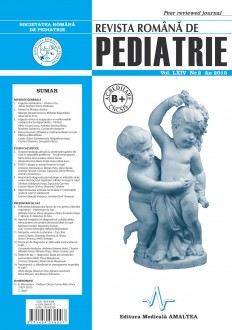SELECT ISSUE

Indexed

| |

|
|
|
| |
|
|
|

|
|
|
|
|
|
|
HIGHLIGHTS
National Awards “Science and Research”
NEW! RJP has announced the annually National Award for "Science and Research" for the best scientific articles published throughout the year in the official journal.
Read the Recommendations for the Conduct, Reporting, Editing, and Publication of Scholarly work in Medical Journals.
The published medical research literature is a global public good. Medical journal editors have a social responsibility to promote global health by publishing, whenever possible, research that furthers health worldwide.
THE IMPORTANCE OF VIRAL ETIOLOGY DETERMINATION IN SEVERE LOWER RESPIRATORY TRACT INFECTIONS IN INFANTS AND CHILDREN
Alexandru-Ioan Ulmeanu, Carmen Zapucioiu, Maria Dorina Craciun and Coriolan Ulmeanu
ABSTRACT
Introduction. Community-acquired pneumonia is one of the leading causes of death worldwide in children under 5 years. In practice, viral detection using multiplex PCR is becoming increasingly used, it is most useful to understand the epidemiology and impact of viruses on the pediatric population but there are still many debates regarding the influence of viral detection on patient care.
Objectives. In this study we aimed to analyze the impact of viral etiology determination on the duration of hospitalization and on the administered treatment.
Material and methods. The selection criteria was: children between 0-5 years with severe lower respiratory tract infection. We have analyzed three groups of patients: a group with specified viral infection, a second group with unspecified viral infection and a third group with bacterial infection.
Results. In the analyzed period 72 children under 5 years of age who have shown signs of acute respiratory failure have been diagnosed with a specifi c viral infection, only 2% of the total viral infections. The main etiology was represented by respiratory syncytial virus (RSV) in 73.5% of cases, followed by Influenza 11%, Parainfluenza 4.2%, metapneumovirus (hMPV), Rhinovirus, Adenovirus and Bocavirus all with 2.8%. Within the unspecified viral infection group antibiotics were used in 85.5% (n = 53) of the cases. Within the specified viral infection group although viral etiology was firmly established antibiotics usage rate was higher 92% (n = 57). Duration of hospital stay was 2,5 days higher in the viral specified group compared with the unspecified one. Thus we found that although the diagnosis of viral infection was certainly given because of severe clinical picture and young age of children the expenses were 30% higher.
Conclusions. In our study, RSV is the most common virus involved in the etiology of viral LRTI and is encountered in the most severe forms of the disease especially in young infants and prematures. Antibiotics are commonly used in the severe forms of LRTI, even if the viral etiology is certain and the groups of antibiotics used are similar. Determination of viral etiology has not reduced hospitalization, nor has led to changing of physician therapeutic approach.
Keywords: pnemonia, bronchiolitis, viral pneumonia, hospital cost, antibiotics
